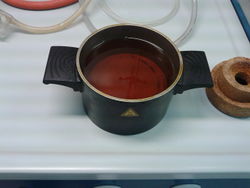Difference between revisions of "Heating bath"
| Line 9: | Line 9: | ||
==Types== | ==Types== | ||
===Water bath=== | ===Water bath=== | ||
| − | The most common type of bath, it consists of a borosilicate glass or metal open pot filled with water. Distilled water is preferred, to limit corrosion of the pot. Water often used as it has high heat capacity, but the biggest downside is that it will release vapors at high temperature. | + | The most common type of bath, it consists of a borosilicate glass or metal open pot filled with water. Distilled water is preferred, to limit corrosion of the pot. Water is often used as it has high heat capacity, but the biggest downside is that it will release vapors at high temperature. |
===Oil bath=== | ===Oil bath=== | ||
Revision as of 20:42, 30 July 2019
 |
This article is a stub. Please help Sciencemadness Wiki by expanding it, adding pictures, and improving existing text.
|
A heating bath is a heat transfer setup which is designed to transfer heat to a reaction flask, by using a liquid or powdered medium. Heating baths are often used in combination with a separate heating source, although heating bath devices are available and used.
Contents
Design
Heating baths are open metal containers, which contain a high temperature boiling fluid, which is heated by a separate heating source. The purpose of the fluid bath is to give an homogenous heating of the reaction flask as well as maintaining a constant temperature.
Specialized heating baths have an integrated fluid bath with an internal heating element, and the temperature is controlled via a thermostat.
Types
Water bath
The most common type of bath, it consists of a borosilicate glass or metal open pot filled with water. Distilled water is preferred, to limit corrosion of the pot. Water is often used as it has high heat capacity, but the biggest downside is that it will release vapors at high temperature.
Oil bath
Uses oil as heat carrying medium. The most common oil used are silicone oil, mineral oil, olive oil, cottonseed oil. While oil has lower heat capacity than water, it can reach higher temperature and is less volatile. Oil baths should not be heated using an open flame without a thermometer or some other temperature controller, as in the event the smoking point of the respective oil is reached, the open flame may ignite the oil vapors.
Liquid metal bath
Low melting point alloys, such as Wood's metal (m.p. 70 °C), are used to heat reaction flasks to high temperatures, and can reach temperatures higher than those achievable with an oil bath.
Other alloys used are: Bi-Pb-Sn-Cd-In-Tl (41.5 °C), Cerrolow 117 (47.2 °C), Cerrolow 136 (m.p. 58 °C), Cerrosafe (74 °C), Field's metal (m.p. 62 °C), Galinstan (−19 °C), Rose's metal (m.p. 94-98 °C), etc.
While mercury would be an attractive metal bath, heating releases toxic and harmful mercury vapors, so it's best to avoid this idea.
Sand bath
While sand isn't a very good heat conductor, it's readily available and can be used to heat vessels at high temperatures.
Powdered metal
Aluminium or copper powder can be used as an effective heat carrying medium, though you will need a lot of powder. Repeated heating will oxidize the metal powder further, which limits heat transfer, as aluminium and copper oxides doesn't conduct heat as good as the metal.
Salt bath
Table salt (NaCl) has a thermal conductivity of 6.15 W/(m·K) at 16 °C, which allows it to transfer heat more effectively than water or oil. Biggest disadvantage is that chloride ions are corrosive to metal pots, which means that glass items are more suitable for heating.
Some SM users have found that salt baths aren't very effective at heat transfer, while others have found the opposite. Moisture seems to be a problem when heating it, as it tends to lump and harden.
Thermal beads
Thermal beads consist of small round-shaped aluminium beads, a few mm in diameter. The main advantage of using thermal beads is that it's clean, easy to remove and there is little risk of contaminating the reagents.
Wax bath
Paraffin wax can be used as a high temperature bath, as it boils at a higher point than oil. Main disadvantage is that it tends to leave lots of wax on the flasks, which is a pain to properly remove.
References
Relevant Sciencemadness threads
- waterbath vs. steambath
- heating element for water bath
- Oil bath
- Suggestions for oil-bath oil?
- Using a small deep fryer as an oil bath
- 300 deg/C oil bath
- How to make an oil bath???
- Setting up a Sand Bath
- Sand baths
- Metal Shot Heating Bath
- Copper wool "bath"?
- Table salt heating bath?
- Using table salt in heat bath?
- Oil bath, Sand bath, Salt bath, Air bath?
- heating media's for heat bath ?!
